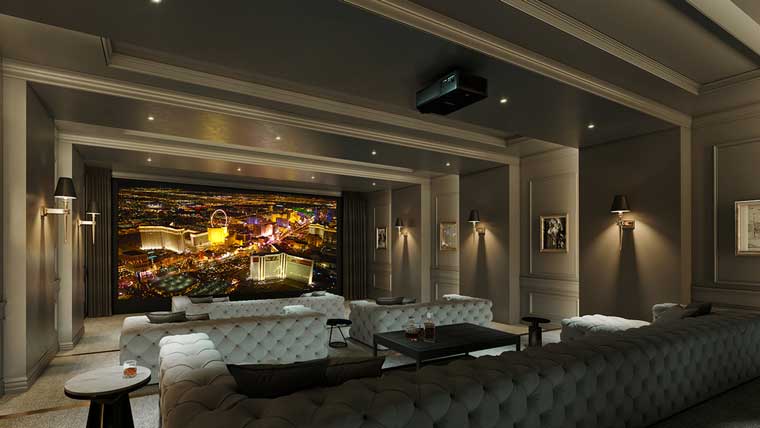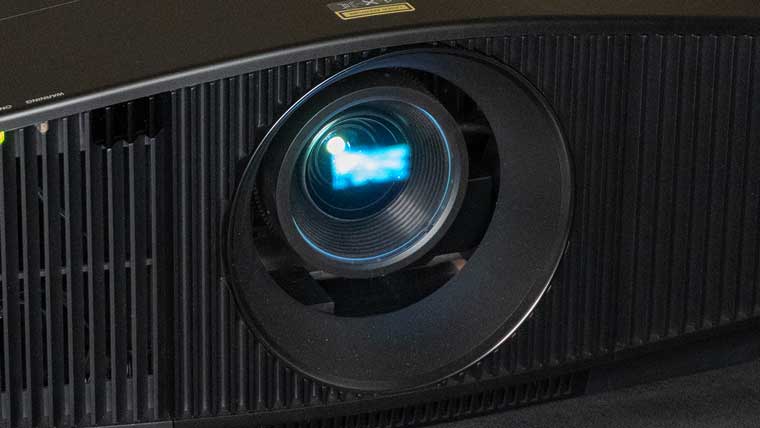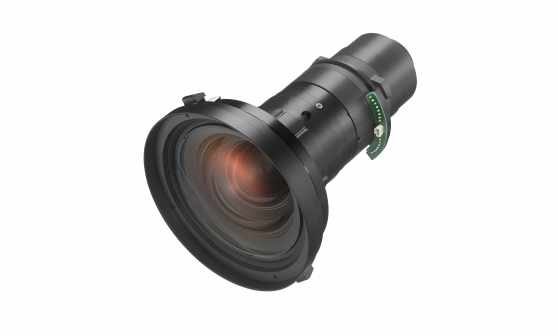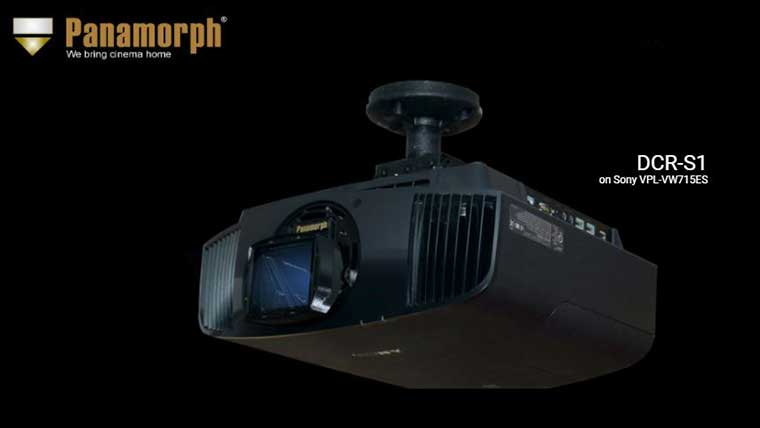
Lenses – Throw Distances and Technologies
The more you understand on how the projector’s lens affects the quality of the projected image, the better you will be at choosing the right projector.
Throw Ratio and Zoom Range
When choosing a lens, its throw ratio is an important factor. Throw ratio is the ratio of the distance from the lens to the screen (throw) to the screen width. Lower throw ratio results in a shorter throw distance. A variable zoom lenses’ throw ratio can be adjusted for example 1.4:1 (wide angle) to 2.73:1 (telephoto) which means it has a zoom range of about 2.1.
The lens on many 3LCD and LCoS home theater projectors have a zoom range of 2:1. Depending on the throw ratio of the lens, for a 100″ diagonal 16:9 screen, that means the projector could be mounted between 10.5 feet to 21 feet away.
How Zoom Range Affects Brightness
Brightness, defined here as Lumens, is one of the most obvious specs you see, but depending on how/where you set up your projector, brightness can vary by over 30 percent.
Where a projector is placed along with the throw range and quality of the lens can have a noticeable impact on light output. When a lens is in wide-angle mode (the largest image it is able to produce from a specific distance) it will produce more lumens and when it is in telephoto mode it produces less.
A lens with a 2:1 can provide tons of placement flexibility but remember if you mount it 10.5 feet from the screen, the projector will output more light (Lumens) then if it is mounted 21 feet back.
There is no straight simple formula, because a lens’ design has an impact on the actual amount of brightness change, but with a 2:1 lens, it could be as much as 30%.
If, on the other hand, the projector has a far more limited lens, say with a zoom ratio of 1.2:1, then, the change in brightness from one “extreme” to the other, becomes minimal, and not a serious consideration.
Most of the DLP projectors have limited zoom lens (1.1:1 to 1.3:1), so there isn’t much to concern ourselves with there. But, with the 3LCD, and LCoS projectors, where all of them seem to have at least 1.5:1, and most are around 2:1, where you place the projector can matter a lot.
Types of Lenses

Ultra Short Throw Lens
An ultra short-throw (UST) can be placed inches away from the projection space eliminating the possibility of interrupting projected content by walking in front of and breaking the protectors light path, casting shadows on the screen You can also use ultra-short throw lenses to create a cleaner and more seamless visual area, with no obstruction to seating, maximizing the space. When space is tight UST gives you a range of options for installation and can display an image up to 120” from less than two feet away. A UST lens is combined with an ambient light rejecting screen is an excellent solution for an environment with a large amount of ambient light.
Ultra-short throw lenses are available for many interchangeable lens projectors but they are usually more expensive than a standard lens. This is due to their complex optics required to project a non-distorted image at an extreme angle. This is also why a UST projector or “Laser TV” usually costs more than a standard projector with the same performance. Ultra short throw lenses have usually offered little/no zoom range and they have a throw ratio of 0.37:1 or less.

.
Short Throw Lenses
Short throw lenses can project larger images from a shorter distance than a standard lens, for example about 120 inches from less than 8 feet away. If a large image is desired in a shallow room or the projector needs to be placed in front of the viewers, this type of lens is a great option. A lens with a throw ratio between 0.38:1 to 1.4:1 is considered short throw.

Standard Throw Lenses
Projectors equipped with standard throw lenses are often less expensive than their short-throw counterparts. They are the most common solution and are utilized in classrooms, conference rooms, as well as home theaters. Unlike the short-throws, if someone or something breaks the projected light, it will block the image, obviously this is dependent on where the projector is mounted, but something to take into account.
Long Throw Lens
Sometimes the projector or projectors will need to be mounted very far away from the screen. This is often done in large lecture halls, ballrooms, concert venues, and houses of worship. A lens with a throw ratio above 4:1 is considered a long throw.

Anamorphic Lenses
Most movies that have been made in the past several decades have been filmed using anamorphic lenses so it makes sense to use the same type of lens to project it and get the best performance from the projector when watching movies.
Anamorphic lenses dramatically improve the brightness and visual performance of home theater movie experiences by projecting all the pixels from your image onto your screen, not above and below your screen as letterboxing (when you see black bars above and below the projected image) does.
Picture of Anamorphic lens from CI page on Sony Projector in CI advertorial
Now, even though there are several benefits to using anamorphic lenses, there are a few things to consider. For example, some anamorphic lenses can shed between 5-8% light, depending on the design and quality making for a slightly less bright picture.
Learn More about Lenses






